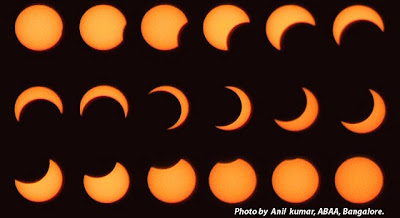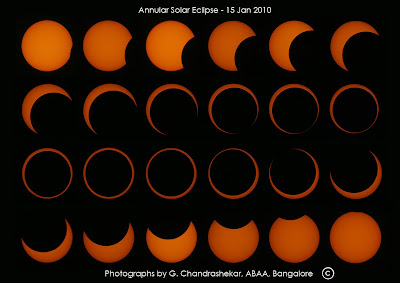
After waiting for more than three decades, this month we have a chance to observe the Annular Eclipse. On January 15th, 2010 we will be able to watch the ASE from many cities in South India. Karnataka will witness the Eclipse as Partial Solar Eclipse, ABAA members will be visiting Rameshwaram which is very close to the central line to observe the event and photograph the Annular Solar Eclipse.
We all know that Annular eclipse takes place when the angular diameter of the Moon is less than that of the Sun.
We will examine the conditions of the Sun and Moon for this Eclipse.
On January 3rd Sun will be closest to Earth with approximate distance of 14,71,01,455 km and on 15th of January the Sun will have a distance of 14,71,53,269.484 km. Using the distance and diameter we can find out the angular size of the object. Distance of Sun we already know and the diameter of Sun is 1,392,000km, dividing diameter by distance and multiplying the result with 57.3 we get angular size of the Sun.
Angular size = (diameter / distance ) * 57.3
on 15th Sun will be at 14,71,53,269.484 km
the Angular size of Sun = (1,392,000/ 14,71,53,269.484) * 57.3
= 0.542 degrees
Applying the same for Moon
Diameter of Moon is 3474km and distance of Moon on 15th is 4,04,714km. Moon will be farthest from Earth on January 17th.
Angular size = (diameter / distance ) * 57.3
= (3474 / 4,04,714) * 57.3
= 0.4918 degrees
As we can see Moon's angular diameter is much smaller than that of the Sun, this results in Annular Eclipse.
Details for Bangalore(January 15, 2010 the Annular Solar Eclipse will be visible as a Partial Solar Eclipse in Bangalore, Karnataka and rest of India):
Start time : 11:17 51° 35' 47" East
Maximum : 13:17 53° 56' 21" West
End Time : 15:10 37° 50' 9" West
Sun coverage at maximum will be around 84% from Bangalore
As stated above, in all parts of Karnataka the the Eclipse will be a Partial Solar Eclipse. Below a list is given as a reference for start, maximum and end times[approximate] on January 15th 2010 for places in
Karnataka.
Times in IST
| Location | Start Time | Maximum | End Time |
| Bidar | 11:31 | 13:26 | 15:13 |
| Gulbarga | 11:27 | 13:27 | 15:11 |
| Bijapur | 11:20 | 13:20 | 15:09 |
| Belguam | 11:14 | 13:14 | 15:06 |
| Raichur | 11:24 | 13:24 | 15:12 |
| Bagalkot | 11:19 | 13:19 | 15:09 |
| Koppal | 11:18 | 13:18 | 15:10 |
| Gadag | 11:17 | 13:17 | 15:09 |
| Dharwad | 11:14 | 13:20 | 15:08 |
| Udupi | 11:08 | 13:15 | 15:06 |
| Shimoga | 11:12 | 13:19 | 15:08 |
| Bellary | 11:19 | 13:24 | 15:11 |
| Davangere | 11:14 | 13:21 | 15:09 |
| Chitradurga | 11:15 | 13:22 | 15:10 |
| Chikmagalur | 11:11 | 13:18 | 15:08 |
| Mangalore | 11:07 | 13:15 | 15:06 |
| Hassan | 11:11 | 13:19 | 15:08 |
| Tumkur | 11:15 | 13:22 | 15:10 |
| Mercara | 11:09 | 13:17 | 15:07 |
| Mysore | 11:12 | 13:19 | 15:09 |
| Chamarajanagar | 11:12 | 13:20 | 15:09 |
| Kolar | 11:18 | 13:25 | 15:12 |
Here are details for few cities in India
INDIA( all Times in UT)
| Location | Start Time | End Time | Maximum | Totality Duration |
| Ahmadabad | 05:57:16.2 | 09:33:32.6 | 07:52:21.6 | |
|---|
| Ambasamudram | 05:37:05.7 | 09:36:28.8 | 07:46:08.7 | 08m23s |
| Aruppukkottai | 05:40:53.1 | 09:38:26.1 | 07:49:18.8 | 06m58s |
| Bangalore | 05:46:31.4 | 09:41:07.4 | 07:53:29.7 | |
| Bombay | 05:46:43.5 | 09:34:30.4 | 07:48:10.7 | |
| Calcutta | 06:37:15.5 | 09:59:05.9 | 08:27:34.8 | |
| Delhi | 06:23:15.8 | 09:40:59.6 | 08:09:10.3 | |
Hyderabad
| 05:59:24.0 | 09:45:17.8 | 08:02:00.3 | |
| Jaipur | 06:15:42.8 | 09:39:11.3 | 08:04:37.8 | |
| Kanpur | 06:25:18.6 | 09:48:12.2 | 08:14:56.1 | |
| Karaikkudi | 05:44:19.1 | 09:40:04.7 | 07:52:05.5 | 07m06s |
| Kumbakonam | 05:48:10.5 | 09:41:55.6 | 07:55:08.5 | 04m02s |
| Lucknow | 06:27:28.0 | 09:48:58.7 | 08:16:22.5 | |
| Madras | 05:55:32.4 | 09:45:13.9 | 08:00:40.5 | |
| Madurai | 05:41:47.0 | 09:38:56.7 | 07:50:03.5 | 03m18s |
| Nagappattinam | 05:49:17.7 | 09:42:19.8 | 07:55:59.5 | 08m00s |
| Nagercoil | 05:35:56.2 | 09:35:44.9 | 07:45:07.1 | 09m51s |
| Nagpur | 06:09:58.8 | 09:47:09.6 | 08:07:46.4 | |
| New Delhi | 06:23:04.2 | 09:41:00.7 | 08:09:06.0 | |
| Palayankottai | 05:38:02.4 | 09:36:54.5 | 07:46:55.5 | 09m05s |
| Patna | 06:34:42.2 | 09:55:27.8 | 08:23:51.9 | |
| Pudukkottai | 05:45:04.3 | 09:40:29.0 | 07:52:42.1 | 05m03s |
| Pune | 05:48:34.2 | 09:36:47.1 | 07:50:44.5 | |
| Quilon | 05:34:31.1 | 09:35:19.6 | 07:43:58.5 | |
| Rajapalaiyam | 05:38:56.2 | 09:37:32.6 | 07:47:42.9 | 03m34s |
| Sivakasi | 05:39:47.2 | 09:37:55.7 | 07:48:24.9 | 05m47s |
| Thanjavur | 05:47:02.9 | 09:41:25.1 | 07:54:15.8 | 03m36s |
| Tirunelveli | 05:37:57.5 | 09:36:52.7 | 07:46:51.6 | 08m57s |
| Trivandrum | 05:34:47.5 | 09:35:20.7 | 07:44:11.6 | 07m16s |
| Tuticorin | 05:39:32.6 | 09:37:35.4 | 07:48:09.3 | 09m44s |
| Virudunagar | 05:40:35.9 | 09:38:20.0 | 07:49:05.1 | 05m36s |
| Vishakhapatnam | 06:14:29.9 | 09:52:15.1 | 08:13:35.9 | |
Here is a list of Past and Future dates of Annular Eclipse that were and will be visible from India.
1025 Nov 23rd South India
1087 Aug 01 South India
1093 Sep 23rd South India
1107 Dec 16th Middle India
1119 May 11 Middle India
1130 Oct 4th South India
1147 Oct 26th Middle India
1148 Oct 20th Middle India
1162 Jan 17th North India
1174 Nov 26th North India
1184 Nov 05th South India
1189 Feb 17th Middle India
1191 Jun 23rd Middle India
1206 Mar 11th North India
1217 Aug 04th North India
1290 Sep 05 North India
1292 Jan 21st North India
1344 Oct 7th North India
1376 Jul 17th South India
1483 May 18th North India
1474 Oct 11th North India
1517 Jun 19th South India
1528 Nov 12th Middle India
1556 Nov 02 South India
1561 Feb 14th North India
1590 Jul 31 North India
1610 Dec 15th South India
1615 March 29 South India
1644 Sep 01 North India
1665 Jan 16th Middle India
1676 Jun 11th South India
1692 Feb 17th North India
1719 Feb 19th North India
1720 Aug 4th North India
1746 Mar 22nd North India
1758 Dec 30 Middle India
1763 Apr 13th North India
1774 Mar 12th Middle India
1793 Sep 05th North India
1840 Mar 04th South India
1847 Oct 09th Middle India
1857 Sep 18th North India
1872 Jun 06th South India
1890 Jun 17th North India
1901 Nov 11th South India
1933 Aug 21st North India
1944 Jul 20th Middle India
1965 Nov 23rd North India
1976 Apr 29th North India
2010 Jan 15th Sout India
2019 Dec 26 South India
2020 Jun 21st North India
2031 May 21 South India
2074 Jan 27 South to North
2085 Jun 22nd South India
Happy Observing and Clear skies








.JPG)


















































